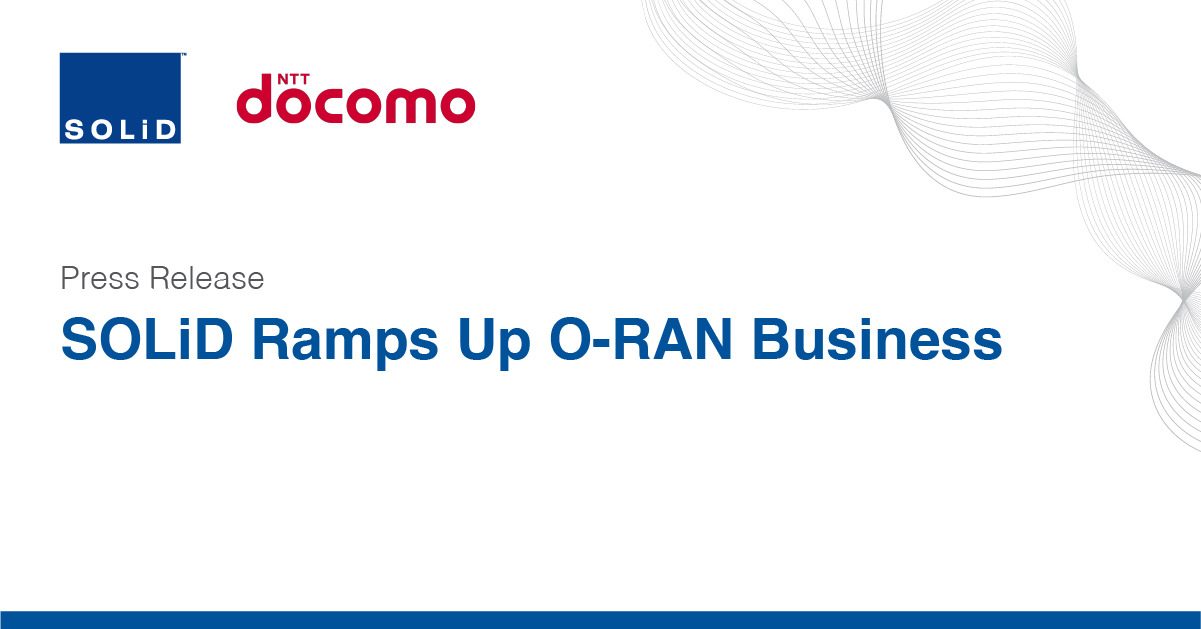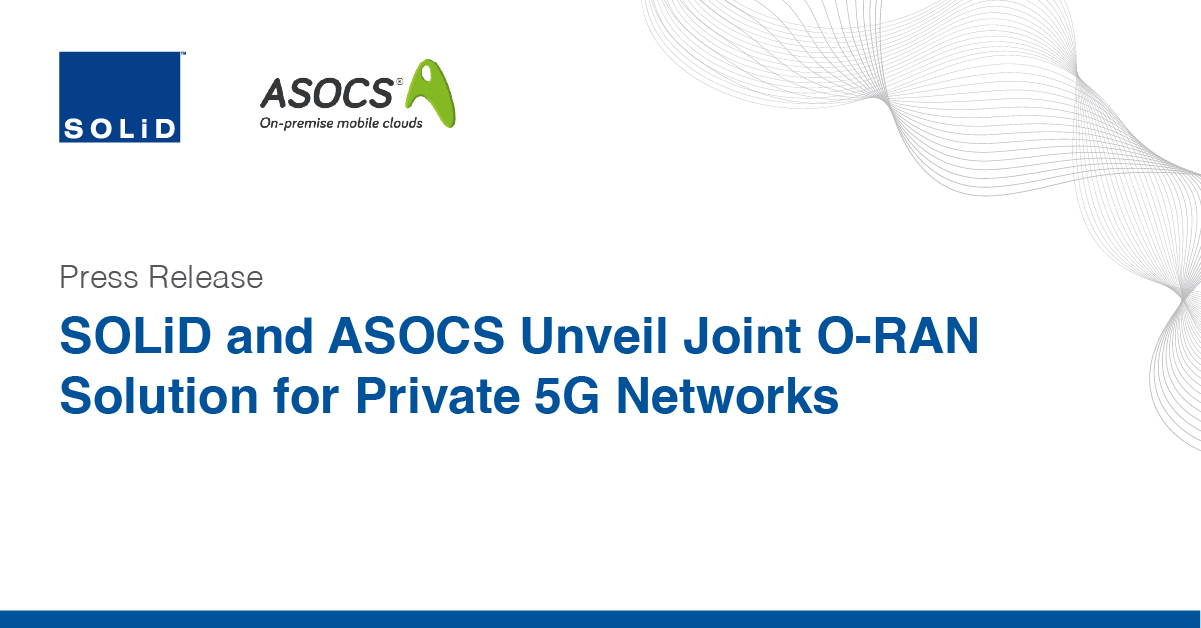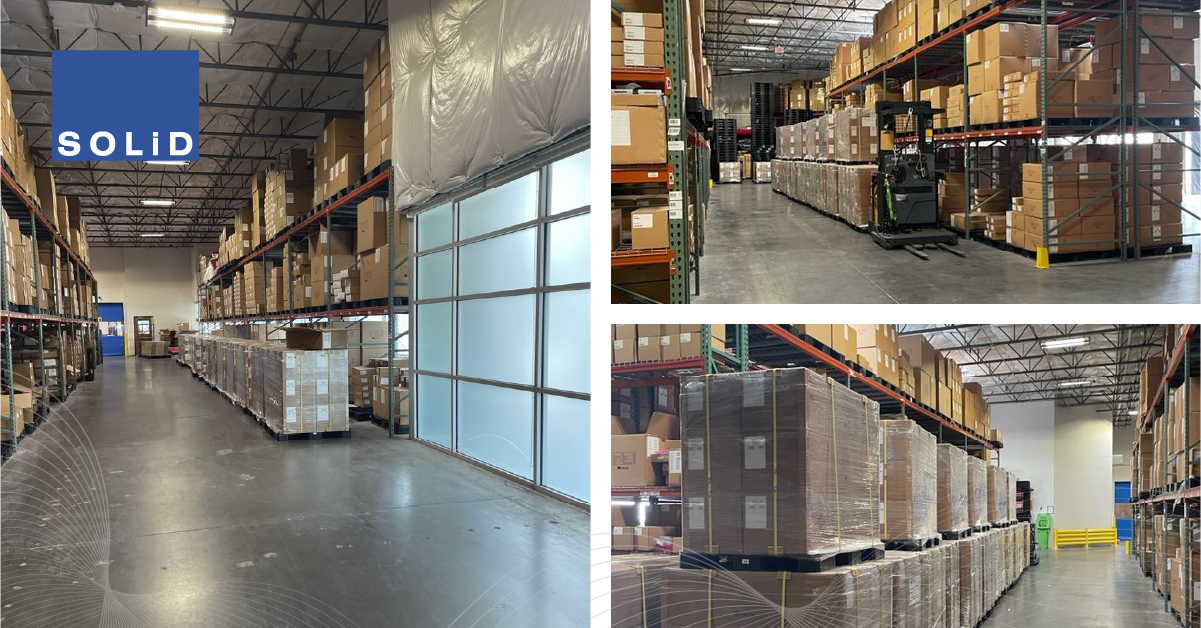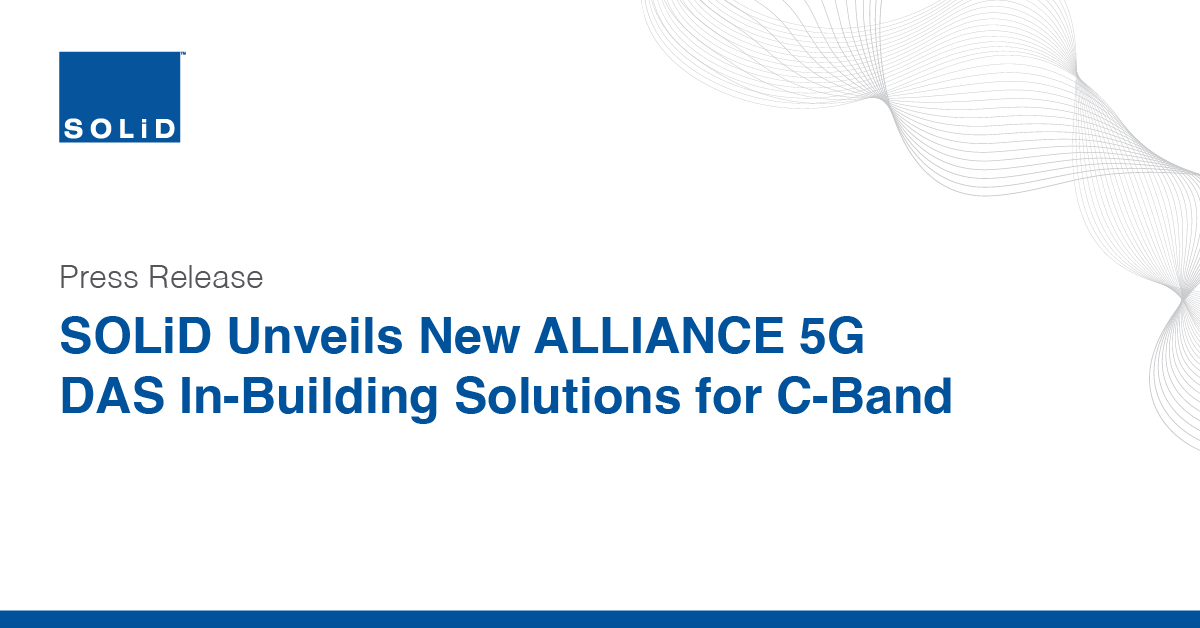SOLiD Ramps Up O-RAN Business
October 4, 2023 – Today, SOLiD joined as a new radio unit (RU) partner for OREX®, NTT DOCOMO's global Open RAN service brand. NTT DOCOMO officially confirmed SOLiD's participation on September 27 while unveiling the new lineup of OREX services at MWC Las Vegas. OREX is DOCOMO's Open RAN service brand, developed in collaboration with multiple global vendors.
"The O-RAN market is poised for significant growth, attracting the interest of communication equipment companies," said Dae-Young Kim, Ph.D., Executive Vice President, SOLiD. "SOLiD achieved over 17 billion KRW in O-RAN-related sales last year, and it's among the few companies where the O-RAN business is translating into actual revenue."
In fact, the global O-RAN market is projected to witness substantial growth, with an estimated compound annual growth rate (CAGR) of 36.9%, increasing from $1.3 billion in 2022 to $8.9 billion in 2028, according to market research and consulting firm KSI.
SOLiD has recently demonstrated remarkable achievements in the O-RAN sector, including a series of successful demonstrations at the global O-RAN proof-of-concept event organized by the international O-RAN ALLIANCE standardization organization.
The open wireless network O-RAN technology disaggregates the hardware and software of wireless communication equipment, such as base stations, enabling interoperability between base station equipment from various manufacturers. This provides telecommunications companies advantages in expanded equipment options, reducing dependency on a single equipment provider, and lowering infrastructure deployment costs. Due to these benefits, both equipment companies and mobile network operators (MNOs) are working to advance O-RAN technology.
Leveraging its established O-RAN technology expertise both domestically and internationally, SOLiD has accomplished various milestones. In addition to becoming a partner in NTT DOCOMO's OREX, SOLiD has entered into a partnership with ASOCS, a leading provider of private 5G network software solutions, to offer O-RAN-compatible solutions. Moreover, SOLiD was exclusively selected for the mobile communication service modernization project at Signal Iduna Park, the home stadium of Borussia Dortmund in the German Bundesliga, and is actively setting up a network in an O-RAN environment in collaboration with German Telecommunication Company 1&1 Drillisch.
"SOLiD’s selection as an OREX supplier to NTT DOCOMO is a logical progression following the recent global O-RAN Plugfest," said Dae-Young Kim, Ph.D., Executive Vice President, SOLiD. "We are determined to maintain our strong market leadership position in the O-RAN market, which is expected to experience substantial growth in the future."
Mapping the Evolution to Multi-Operator Networks
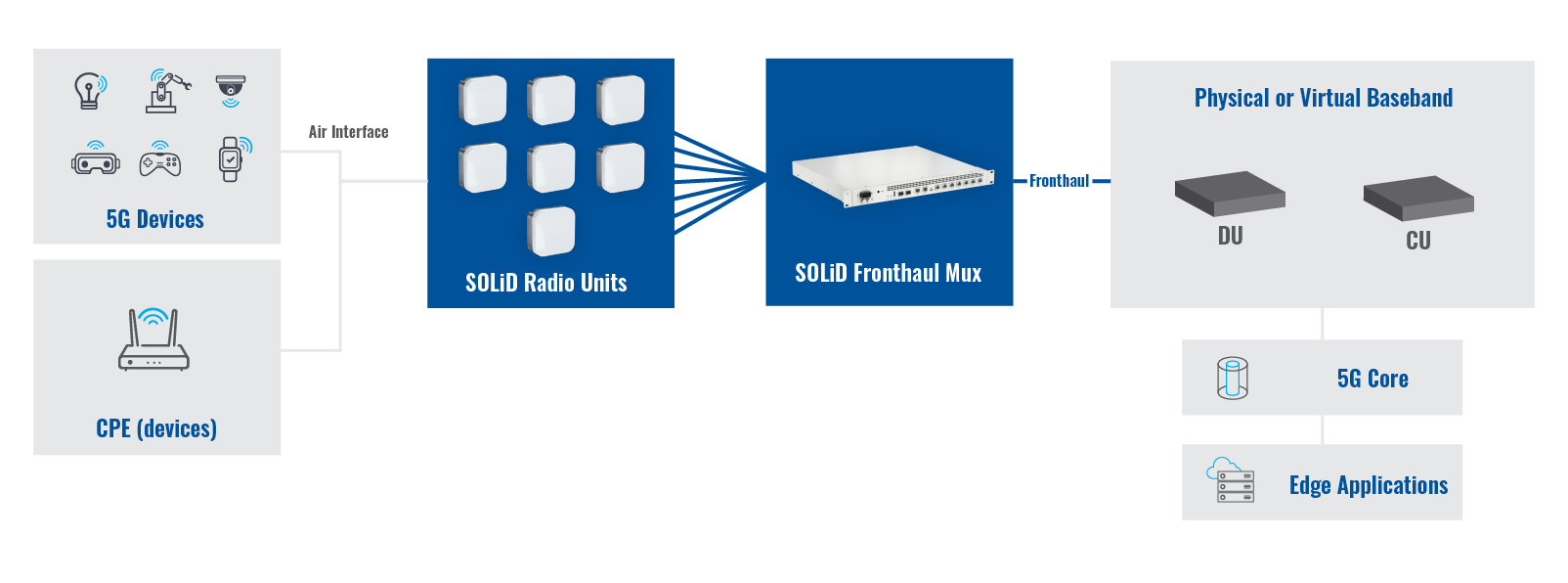 Mobile networks are constantly evolving, and advancements in neutral host distributed antenna system (DAS) technology are keeping pace, enabling more efficient, scalable, and reliable connectivity. As a result, wireless in-building service quality is generally much improved over what it was in the early days of DAS, even as demand for mobile data skyrockets. And yet, to properly receive the latest wireless signal sources from multiple operators, in-building DAS systems must continue evolving to match mobile network operator (MNO) infrastructure transformations.
Mobile networks are constantly evolving, and advancements in neutral host distributed antenna system (DAS) technology are keeping pace, enabling more efficient, scalable, and reliable connectivity. As a result, wireless in-building service quality is generally much improved over what it was in the early days of DAS, even as demand for mobile data skyrockets. And yet, to properly receive the latest wireless signal sources from multiple operators, in-building DAS systems must continue evolving to match mobile network operator (MNO) infrastructure transformations.
The growing adoption of 5G technology is driving the need for further changes in the mobile network, including greater cell site densification. However, more than 450,000 outdoor small cell nodes were already operating across the U.S. by the end of 2022, making new site build-out increasingly difficult. This challenging situation requires new approaches to network deployment and management.
Transformation Ahead
Today, in-building coverage is commonly provided by traditional neutral host DAS infrastructure shared by multiple operators. This familiar in-building coverage model has been used for many years and is universally accepted and proven. Although MNOs share the DAS equipment, they have their own radio access network (RAN) infrastructure, providing full visibility and control of the radio access network.
As MNOs face ever greater economic pressures and coverage mandates worldwide, the need to further drive down costs is inevitable even as they strive to densify coverage. Active RAN sharing helps MNOs reduce costs and avoid potential performance and maintenance problems caused by over-building their networks. This shared infrastructure approach to network deployment provides several benefits, from improved cost efficiencies to reduced environmental impacts.
When transitioning to an active shared RAN model in the future, MNOs will have various neutral host network configuration possibilities as follows, ranging from minimum to maximum sharing:
MORAN
With a multi-operator RAN (MORAN), multiple MNOs share radios, antennas, towers, and power, but each has dedicated baseband units (BBUs). A ‘shared O-RU’ feature, which the O-RAN Alliance working group four is standardizing, is a cost-effective option in O-RAN networks. This configuration allows full visibility and control of BBU equipment but requires changes to fronthaul switches to enable multiple interfaces. A shared, multi-operator RAN deployment can be used with licensed spectrum for a public network or with Citizens Broadband Radio Service (CBRS) spectrum for private networks - either over general authorized access (GAA) channels or using priority access license (PAL) channels for dedicated bandwidth.
MORAN + BBU Sharing
The amount of RAN sharing increases marginally with MORAN + BBU sharing. This co-location model involves multiple operators sharing all RAN equipment while each MNO still uses its dedicated spectrum. This configuration helps reduce BBU and fronthaul costs but still limits the visibility of the RAN network.
MOCN
Finally, with the multi-operator core network (MOCN) architecture, multiple MNOs share one or more CBRS channels to achieve maximum RAN sharing and cost efficiency. A key difference between MOCN and MORAN is the sharing of spectrum, allowing MNOs to pool spectrum allocations for greater resource efficiency. Although the lead operator in this deployment may have access to some dedicated spectrum channels and RAN control, this scenario affords limited visibility of the RAN for all other operators and GAA spectrum dependency.
DAS Evolution
As future mobile networks evolve to progressively greater architecture sharing, cost and efficiency benefits will increase, even as operator flexibility and control decrease. Likewise, these macro network changes will also impact how in-building DAS equipment operates, requiring DAS architecture to evolve as well. Future DAS architecture will share the distribution and intermediate layers between the DAS headend and the MNO networks.
When considering the difference in shared spectrum between DAS/MORAN and MOCN, MOCN will be an efficient solution for small venues or enterprise networks where coverage is more critical than capacity. We could also expect further enhancements from a neutral host DAS standpoint when converged with MORAN.
Currently, most neutral host DAS platforms use separate RANs for each MNO, but greater efficiency is possible if the RAN portion becomes MORAN. Fundamentally, RAN provides capacity, and neutral host DAS distributes capacity from multiple MNOs to multiple antenna points. In a case of extreme capacity sharing, neutral host DAS becomes more cost-efficient than MORAN because MORAN radios with a function of (Low) PHY will be more expensive than DAS radios. In fact, neutral host DAS with an O-RAN (eCPRI) interface to MORAN with BBU sharing could be the most efficient in-building solution.
A Solid Future
With the inevitable evolution of mobile networks, a RAN sharing model may eventually offer greater cost-efficiency when providing in-building coverage for small and medium-sized venues. This transformation won’t happen overnight, but when it does, SOLiD’s neutral host DAS will evolve to keep pace. In fact, SOLiD already offers Open RAN architectures to support private networks over CBRS. These next-generation architectures provide a logical stepping stone to future DAS components that work with RAN sharing.
SOLiD is leading this progression at the forefront of in-building technology advancements to ensure that DAS systems continue evolving in lock step with MNO infrastructure. Trust SOLiD to deliver the latest technologies for always-on, everywhere, in-building connectivity and interoperability testing for both public and private networks. To learn more, visit https://solid.com/us/open-ran/
SOLiD and ASOCS Unveil Joint O-RAN Solution for Private 5G Networks
Scalable, CBRS-compliant, Open RAN solution unleashes private 5G and industrial IoT for Industry 4.0 transformation
SOLiD, the leader in cellular in-building mobile coverage, and ASOCS, a leading provider of private 5G network software, today announced a partnership to deliver a complete O-RAN-compliant solution for private 5G and Industrial IoT (IIoT) networks. The joint solution enables rapid deployment of scalable private 5G campus networks with intelligent real-time positioning using the Citizens Broadband Radio Service (CBRS) spectrum.
The new private 5G network solution comprises the SOLiD CBRS O-RAN Radio Unit (O-RU), the ASOCS CYRUS® virtual O-RAN Distributed Unit (O-DU) and Centralized Unit (O-CU), and ASOCS Hermes NGP real-time positioning software. The CBRS-compliant solution, certified by the OnGo Alliance, empowers a range of mission-critical Industry 4.0 use cases, such as manufacturing automation, predictive maintenance, real-time asset tracking, and occupational health and safety.
The SOLiD CBRS O-RU complies with O-RAN ALLIANCE fronthaul specifications, supporting 4G LTE and 5G New Radio (NR) in standalone (SA) or non-standalone (NSA) architecture. The O-RU is compatible with various virtual or physical baseband products via an eCPRI interface. To improve private 5G network service agility, scalability, and efficiency, the SOLiD Fronthaul Multiplexer (MUX) technology eliminates the need for dedicated bandwidth for each RU, enabling more economical use of the CBRS spectrum.
“With the power of AI, the ASOCS software-as-a-service solution enables a cloud-based private 5G network with real-time indoor/ outdoor positioning intelligence to connect data-driven Industry 4.0 edge applications with high accuracy and low latency,” said Niv Zimmerman, vice president of solutions, ASOCS. “Together with SOLiD, we offer a unique, comprehensive solution for deploying private 5G and IIoT networks in a scalable model.”
“SOLiD is at the forefront of innovating connectivity with Open RAN architecture, changing how mobile network operators, system integrators, and manufacturers build tomorrow’s networks,” said Yong Hoon Kang, Ph.D., chief technology officer, SOLiD Americas. “The powerful combination of the SOLiD CBRS O-RAN Radio Unit and ASOCS software unleashes 5G to enable fast, turnkey deployment of robust and secure private in-building networks that transform the business environment.”
“With low latency, fast data speeds, high reliability, and solid security, the true promise of 5G over CBRS is to enable Industry 4.0 applications for greater productivity and profitability,” said Alan Ewing, executive director, OnGo Alliance. “The SOLiD and ASOCS collaboration is an outstanding example from two of our members of how 5G NR and CBRS come together to deliver exceptional performance.”
SOLiD and ASOCS have completed multiple interoperability tests proving the performance of their Open RAN technologies. To learn more, visit SOLiD and ASOCS in meeting room #1178 at MWC Las Vegas, September 26-28.
How New 5G Radios Impact In-Building Connectivity
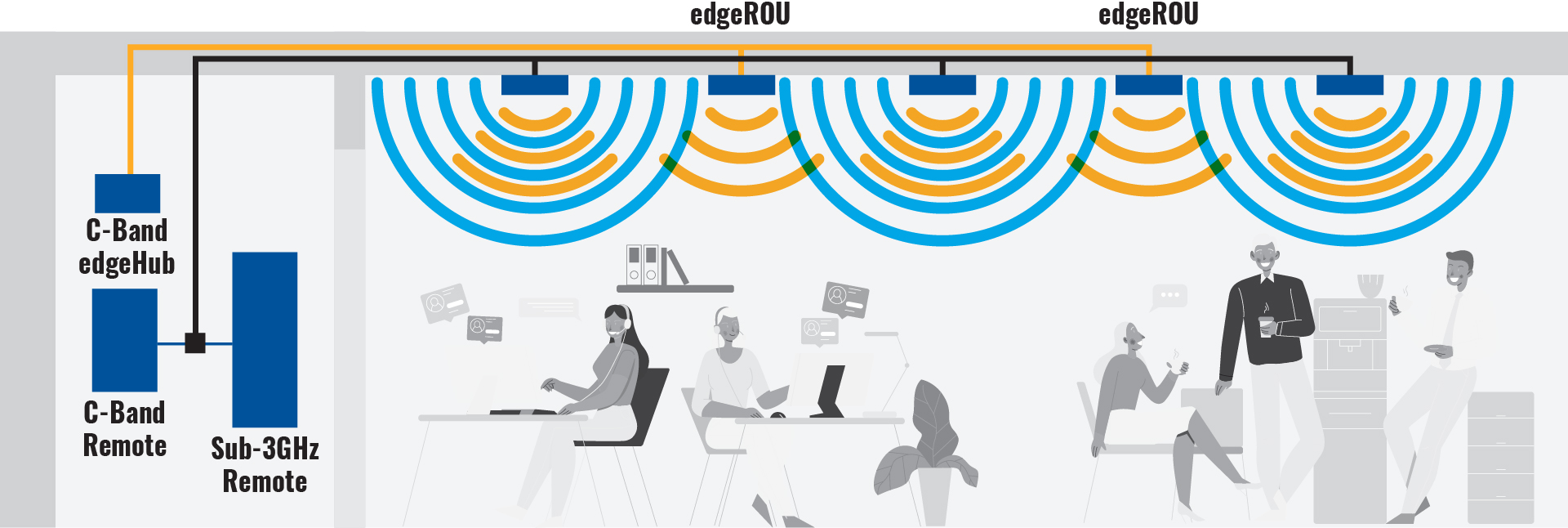
Mobile 5G technology promises to deliver many innovative new services and capabilities, including higher mobile capacity, faster data speeds, and ultra-reliable low-latency connectivity. These advancements are made possible by fundamental changes in the communications network architecture. However, these evolutionary transformations also can affect how 5G networks perform in conjunction with in-building Distributed Antenna System (DAS) systems.
So, what do you need to know about 5G networks to ensure your building tenants, employees, and visitors continue to experience seamless, always-on mobile connectivity?
Introducing 5G NR
As mobile networks evolve from 4G to 5G, significant architectural changes transform how these next-generation networks operate. A key aspect of this transformation is an improved wireless air interface called 5G New Radio (NR), which enables high-capacity throughput delivery. This technology allows the 5G radio access network (RAN) to use radio frequency (RF) spectrum more efficiently for significantly faster and more responsive mobile experiences than legacy 4G LTE networks.
The newest spectrum released for use with 5G NR uses Time Division Duplexing (TDD) — a method of separating uplink (UL) and downlink (DL) transmissions. The TDD method enables UL and DL functions to occur on the same frequency, unlike Frequency Division Duplexing (FDD), which requires two separate RF frequencies to send and receive data. TDD allows the 5G NR to accommodate large blocks of contiguous spectrum, supporting larger channel widths to provide greater capacity and flexibility.
However, the new 5G spectrum exists at higher frequencies with shorter signal propagation, limiting coverage, particularly indoors. To take full advantage of the potential that 5G offers, network managers need to optimize in-building DAS deployments, which may require the replacement of existing antennas and coaxial splitters to ensure high quality for maximum service availability.
Maximize 5G In-Building Connectivity
When deploying and configuring a DAS system today, it’s critical that you consider all the available 5G frequencies used in adjacent macrocell networks and recognize how each frequency band will impact your in-building DAS deployment. To better understand 5G NR technology and the new frequencies that 5G networks use, download the technical brief How to Make the Most of 5G for Improved In-Building Connectivity
Are You Maximizing In-Building DAS Performance?
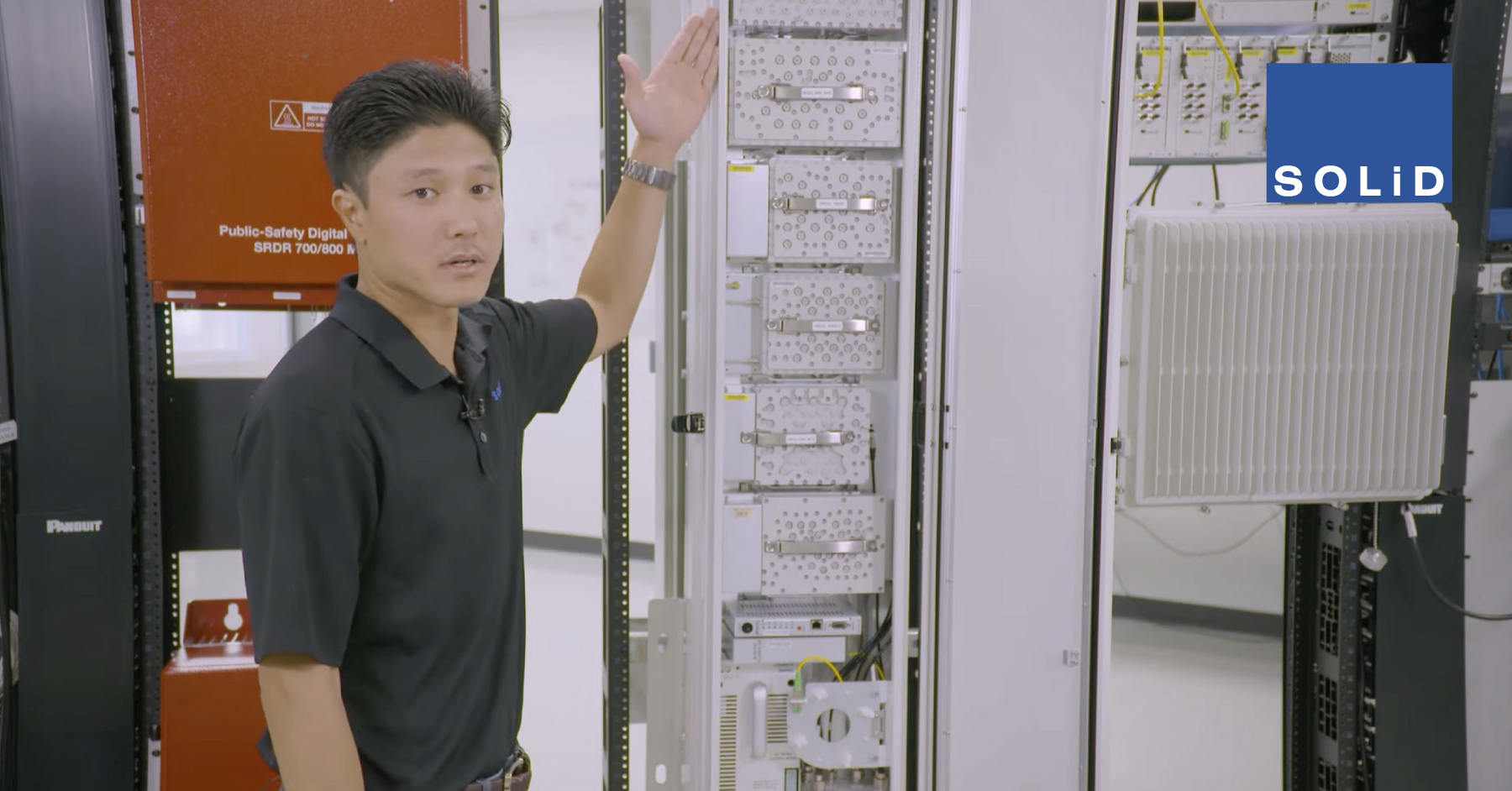
As 5G technology becomes more pervasive worldwide, consumers and business professionals alike expect mobile service with faster speeds, better coverage, and higher quality — anytime and anywhere — including in your building or event venue. By installing the latest distributed antenna system (DAS) technology, you can help ensure that your tenants, visitors, and employees continue to enjoy seamless in-building connectivity. Yet, how do you ensure you get the most benefit out of your DAS equipment?
Evolution to 5G promises more capacity and data speed, but to deliver on that promise, the Federal Communications Commission (FCC) has introduced an array of new frequency bands with varying propagation characteristics. Additionally, next-generation mobile technology enables new features and capabilities, such as ultra-reliable low-latency networks, which require substantial changes in network architecture. All of this means that 5G brings increasing complexity to today’s networks.
So how can you and your network manager make sense of it all to realize the maximum return on your DAS investment?
Call on SOLiD Support
At SOLiD, we offer a suite of support services tailored to each customer’s needs, ranging from help desk telephone support to remote monitoring and maintenance packages. Our experienced DAS experts take the time to fully understand your technical challenges in order to resolve any technical issues as quickly as possible.
The SOLiD commitment to customer service begins with our ‘ACT’ process, during which we Assemble, Configure, and Test the DAS equipment before shipping. This quality control practice significantly reduces the chance of out-of-box failures (historically less than 1%) that could impact deployment timelines and costs.
Our support services team comprises senior-level engineers with more than 15 years of work experience in DAS technology and the RF industry. Plus, the SOLiD support team is directly linked to our R&D department through a streamlined communications channel. This not only ensures that customer requests can be promptly reviewed and resolved but also provides accurate feedback for continuous product improvement.
With our remote support service, SOLiD engineers can help you resolve RF issues, such as unexpected noise or low power. Likewise, our support team can conduct a remote session through Microsoft Teams viewer, Ultraviewer, or AnyDesk to address firmware and DMS issues.
Help Us to Help You
We know your time is valuable, so we want to share a few tips to maximize your interaction with technical support:
- Share as many details as possible about the technical problems you are experiencing. This allows our support engineers to better understand the issues for a successful conclusion.
- When possible, provide prior notification of your need for remote support on critical issues. By allowing us a little extra time to prepare, our DAS experts can deliver more accurate support in a timely manner.
- If you need remote support, be sure to have information on hand about your system, such as the model number and firmware version.
- Instead of contacting your SOLiD salesperson, the fastest way to get help is to reach our support team directly. You can either call (888) 409-9997 and select option 2 or e-mail support@solid.com to create an automatic support ticket via the ticketing system.
No matter the size and configuration of your DAS deployment, the SOLiD team aims to ensure you get the maximum return on your investment with fast delivery, peak performance, and a suite of support programs to exceed your expectations. To learn more, visit: www.solid.com/us/services/support-2.
Get in Sync with 5G
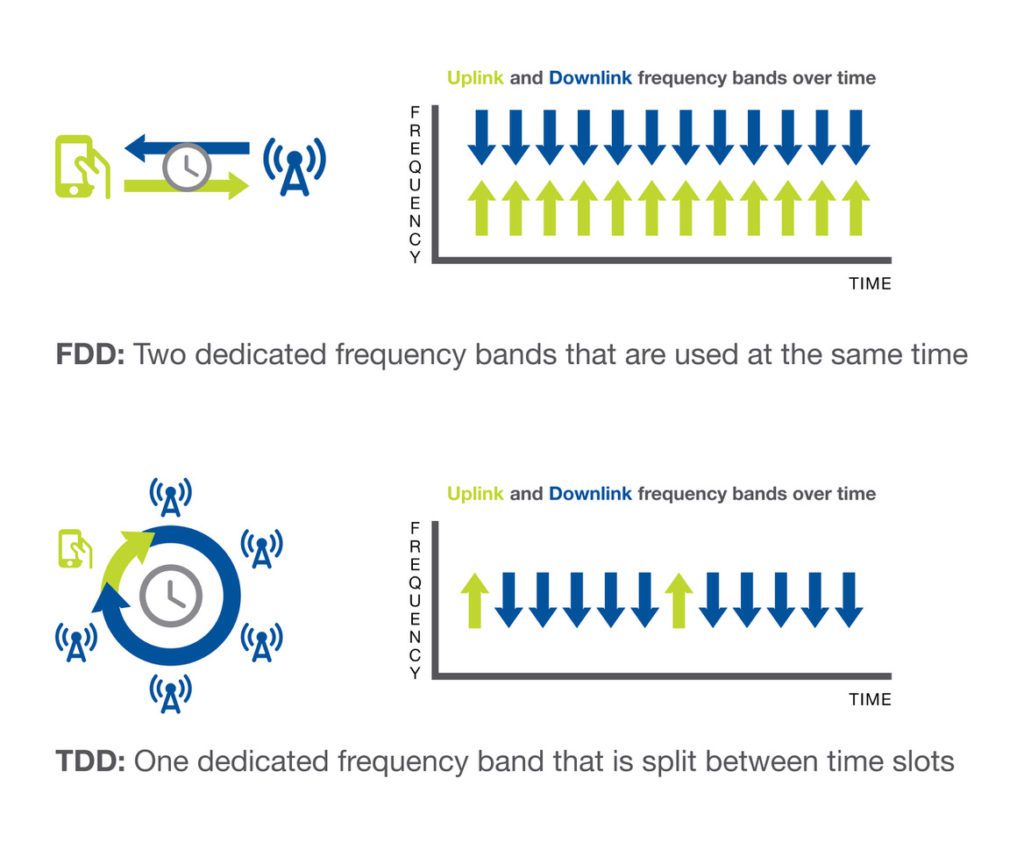
The ever-growing demand for mobile connectivity is driving a transformation in wireless technology. Without a doubt, the most significant shift happening right now is the adoption of 5G. Next-generation 5G technology allows enhanced mobile broadband (eMBB) to deliver faster speeds across a wide coverage area, opening the door to a wide array of innovative and profitable new use cases — from automated factories and autonomous vehicles, to smart homes and cities.
Many of the new applications that 5G technology enables rely on more stringent performance and lower latency than previous mobile generations were capable of delivering. Achieving these technical requirements, however, requires a fundamental change in how the network uses radio frequency (RF) spectrum. Evolution to 5G introduces new, larger spectrum bands that exclusively use Time Division Duplexing (TDD), versus the Frequency Division Duplex (FDD) timing sequence that legacy mobile communications technologies employ.
Additionally, network operators are building out more dense cell sites in order to deliver sufficient coverage, capacity, speed, and performance in 5G, making it crucial that all the radio access network (RAN) elements and user devices are seamlessly synchronized with each other. Furthermore, 5G also takes advantage of advanced RF optimization technologies, such as massive MIMO, dynamic spectrum sharing (DSS), beamforming, and carrier aggregation, which require accurate timing for proper operation.
Taken together all of these technical complexities contribute to a critical need for precise timing and synchronization in 5G networks.
Timing is Everything
A key difference with TDD spectrum usage is that both the uplink (UL) and downlink (DL) signals are transmitted on the same frequencies, as opposed to the FDD method that uses separate, paired frequency blocks to transmit and receive traffic. 5G technology relies on TDD bands to provide support for larger channel bandwidth and asymmetrical UL / DL channels to make more efficient use of valuable 5G spectrum.
Yet, with both uplink and downlink data transmissions on the same frequency, there is a much greater chance of interference, with any lack of synchronization between UL / DL frames making matters worse. That means that exact time and phase alignment between base stations is required in order to prevent signal interference and dropped calls with TDD. In fact, 5G new radio (NR) specifications introduce very stringent restrictions on TDD transmissions, with an absolute time synchronization margin of just 1.5µs, compared to a margin of 10µs in the previous FDD LTE environment.
These requirements are particularly important when accommodating new use cases. While many service providers typically follow a standard 80/20 rule for downloading and uploading content, this network parameter is likely to cause congestion as traffic patterns change, increasing the odds of interference. For example, faster 5G speeds are expected to continue driving more uplink traffic, such as cloud storage, or the practice of uploading selfie photos and videos in crowded entertainment venues.
To accommodate the need for precise synchronization with TDD, 5G networks use a highly accurate timing sequence called the Precision Time Protocol (PTP) that shares the same time reference from end to end throughout the network. The PTP function maintains time, phase, and frequency synchronization from the network core to the edge of the service provider’s network. This helps to ensure good quality of experience (QoE) for subscribers using the outdoor macro network.
Get in Sync
But what about service indoors where roughly 80 percent of all mobile voice and data traffic occurs? For those commercial buildings, multi-dwelling units (MDUs), and enterprise offices with a distributed antenna system (DAS) deployed in-building, the PTP assurance of 5G timing and synchronization ends where the DAS begins. To provide reliable 5G service and ensure QoE for indoor subscribers, in-building DAS infrastructure needs to support the timing sequence of TDD.
With the SOLiD ALLIANCE DAS platform 2W, 5W, 20W and Multi-Power Remote Optical Unit, synchronization occurs at the remote unit on the edge of the network, not at the system headend. Likewise, the edgeROU fiber-to-the-edge remotes synch at the edgeHUB typically located in the independent distribution frame (IDF) closet on each floor.
By synching closer to the mobile device, our system provides improved timing and synchronization for seamless connectivity, reducing dropped calls and interference in-building. Additionally, if a sync detection module should fail, the area of impacted coverage is minimized. Alternatively, other systems that sync at the headend can suffer from an extra delay caused by the distance from where they sync to user devices, as well as being vulnerable to total outages, resulting in a poor subscriber experience.
The SOLiD DAS platform not only matches exacting timing and synchronization to improve service quality — similarly to how user devices operate — but our DAS technology also minimizes latency in 5G and LTE networks. SOLiD ALLIANCE DAS minimizes latency by using analog RF over fiber, eliminating the need for analog to digital and digital to analog conversions, which can add significant signal delay and latency.
To learn more about how to get in sync with SOLiD, visit www.solid.com/us/products/alliance-das.
Bringing True 5G Vision into Focus with the C-Band

The evolution to 5G is moving at a blistering pace. In fact, the adoption of 5G is happening faster than any previous generation of mobile communications technology. Yet we still have not realized the true vision of this new mobile technology. In the U.S., this is primarily due to a shortage of suitable radio frequency spectrum.
To achieve the full potential of 5G, mobile network operators (MNOs) require broad, dedicated channels, ideally 100 MHz or larger. The 5G standards permit channel bandwidths up to 100 MHz in frequency range 1 (FR1) below 6 GHz and up to 800 MHz in frequency range 2 (FR2) above 6 GHz, typically higher mmWave spectrum from 24 to 40 GHz. All major network operators possess licenses in FR2, but building a network to provide ubiquitous coverage with mmWave is cost-prohibitive due to the very short transmission distances at high frequencies. Therefore, FR1 bands large enough to support 100 MHz channels are the best alternative to provide wide-area 5G coverage that also offers true 5G capabilities.
Except for the 2.5 GHz BRS band used by T-Mobile, each of the legacy bands previously used for 3G and 4G typically provide just 10 to 40 MHz of bandwidth to each network operator, so they could not support 100 MHz channels. As a result, the initial 5G deployments in the U.S. did not enable wireless service providers to maximize their networks' speed and capacity. Still, they did enable coverage maps showing large areas of 5G coverage. Finally, the Federal Communications Commission (FCC) released additional spectra in the C-Band 3.7 to 3.98 GHz and 3.45 to 3.55 GHz to enhance the MNO's 5G capabilities. The U.S. C-Band is a sub-set of the frequency band identified as n77 by the global 3GPP organization that spans 3300 MHz to 4200 MHz.
C-Band will offer significant improvements over the previously released millimeter-wave spectrum for wide-area 5G network deployments. The n77 spectrum has already been used in 5G networks for two to three years by MNOs worldwide, and most 5G networks operate in this mid-band spectrum. Here in the U.S., however, MNOs just recently started switching on their C-Band 5G networks after intense negotiations with the Federal Aviation Administration (FAA) over concerns about interference with airplane radar altimeters.
Now that the U.S. Tier One service providers are using C-Band in their 5G networks, it's important to ensure that existing mobile communications infrastructure is compatible — including your in-building distributed antenna system (DAS) equipment. For building owners, enabling seamless 5G connectivity is crucial to keeping tenants happy as more subscribers adopt this next-generation technology and MNOs begin to turn off previous mobile generations. And for those enterprises wanting to benefit from the latest innovations such as IoT connectivity, analytics powered by machine learning, and smart manufacturing, 5G private networks are the answer to achieving this as smoothly and efficiently as possible.
Learn the ABCs of C-Band
The C-Band was previously reserved for satellite TV transmissions. Still, with advanced digital encoding methods, the satellite companies can "repack" their broadcasts into the upper portion of the band to free up the lower portion for 5G. Interestingly, after auctioning the frequency licenses last year, the FCC is making C-Band available in two phases as they clear the spectrum. This means that MNOs' timeframes for the availability of 5G in the C-Band will vary considerably depending on their licenses, with roll-outs extending from early this year to the end of 2023 and different portions of the band being used in various markets. In other words, the overall deployment picture is far from simple. For example, one MNO received an initial spectrum allocation this year that will shift 80 MHz higher within the band in 2023.
C-Band offers greater capacity with an increased channel size, but the coverage area will be reduced or require more output power to achieve the same footprint as previous frequencies. Additionally, the C-Band spectrum offers just one-fourth of the legacy mobile communications bands' signal propagation characteristics because it spans higher frequencies. As a result, achieving the same coverage footprint with C-Band will require a higher effective output power from the antenna.
Likewise, the higher frequencies also do not penetrate building materials as well as lower frequencies. This means that coverage from outdoor networks is less likely to provide service inside buildings. On the plus side, in-building coverage systems, such as Distributed Antenna Systems (DAS), will have less outdoor network interference to overcome.
A dedicated in-building system can provide reliable C-Band coverage, but the interior building materials impede these higher frequencies. In comparison to legacy mobile communications frequencies at the same power level, indoor C-Band coverage is roughly 15 percent per antenna. For example, an antenna providing a little more than 1,000 square feet of coverage for a 4G 20 MHz channel in the legacy Advanced Wireless Service (AWS) band would cover a little more than 150 square feet with a 5G 100 MHz channel in the C-Band, assuming an office environment with sheetrock walls.
If you have an existing 4G DAS, it may or may not support the new frequencies. However, even if it does, it will certainly require amplifiers that provide 4 to 10 times more output power to match the existing footprint. Yet providing higher power is not feasible if the existing system already uses high output power amplifiers. Under that circumstance, use an overlay system for the higher frequencies, engineered for specific coverage requirements. With the SOLiD Link Budget Analysis tool, you can easily analyze factors unique to your deployment to maximize capacity and coverage.
SOLiD ALLIANCE DAS provides a modular high output power C-Band remote and a lower power fiber-to-the-edge (edgeROU) solution for overlay applications. The modular high output power (20W) remote supports all 380 MHz of licensed C-Band and Auction 110 spectrum with up to 2x2 MIMO in one chassis. The edgeROU also supports the full C-Band with 2x2 MIMO and is available with integrated antennas or external antenna ports. These options enable at least three approaches to add C-Band to your coverage infrastructure. The high-power remote may be integrated with your existing DAS on a remote-by-remote basis if the existing remotes are 2W or 5W. The edgeROU with integrated antennas may provide a complete overlay solution as simple as deploying Wi-Fi. The edgeROU with external antenna ports may integrate with your existing DAS at each antenna location either with the existing antenna, if appropriate, or by replacing the antennas with a model that supports both legacy bands and the C-Band.
All of SOLiD's C-Band amplifiers support the full instantaneous and occupied bandwidth. Full band capability ensures that the system will support the initial spectrum allocations and later transitions when satellite incumbents release the upper end of the band in 2023.
To ensure that your in-building DAS platform is ready for 5G service in the C-Band, select a solution that supports the full C-Band frequency allocation from day one, with multiple output power options to meet the unique needs of your venue.
Transition to Tomorrow
As 5G advances and new frequency bands become available, in-building wireless systems need to keep pace or be left behind. Today's building tenants and enterprise employees expect excellent quality of service everywhere, even indoors, and 5G is no exception. Are you ready to support the C-Band to take advantage of the true 5G promise?
To learn more about how to upgrade your in building DAS system to fully realize 5G, watch our webinar “Are you ready for 5G mid-band?”
Adapting to the New Normal to Fix a Broken Supply Chain
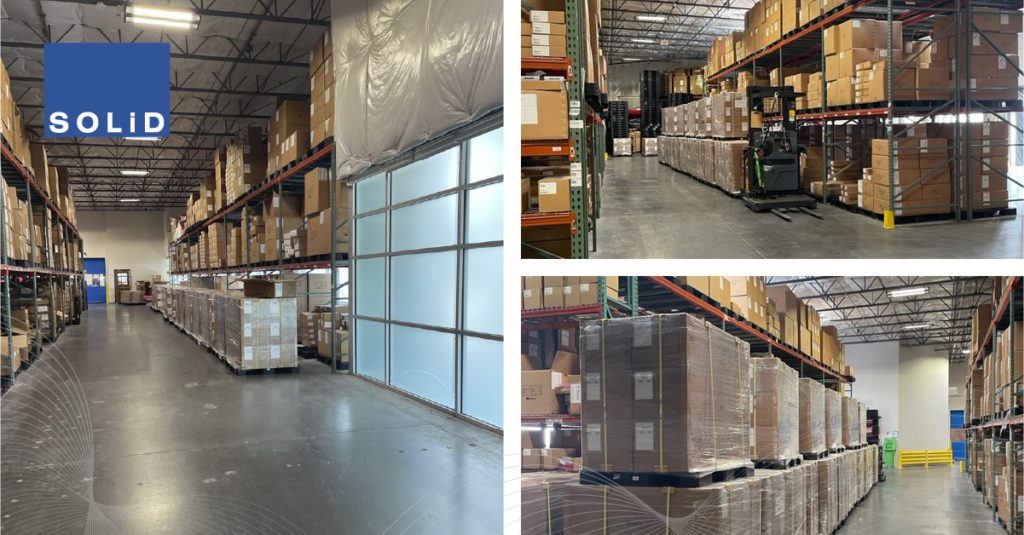
No matter what industry you are working in right now, odds are you’ve experienced at least some impact from supply chain constraints during the past couple of years. When the world economy tried to reboot after being essentially shut down for more than 18 months, we all learned the hard way how interconnected the global supply chain truly is and how much that affects all of us.
Now, as we navigate the ‘new normal’ sparked by the global COVID-19 pandemic, new patterns in supply and logistics are emerging and changing how we predict shifting demand. Some of these patterns will be temporary, while others will set a new baseline for years to come. In other words, business-as-usual is a thing of the past; at least for now.
A Cloudy Forecast
Well-informed, long-range forecasting continues to be critical during this ongoing supply crisis. To date, our ability to work very closely with our customers on forecasting their demand for products means that SOLiD has not had to disappoint our customers by failing to meet delivery deadlines. However, it would seem that others are not doing as well in this regard, because some of their customers are coming to us with demand for products.
On the one hand, this is a good problem to have because we love to work with new customers. On the other hand, the fact that they did not forecast demand with us in advance means that excess inventory could become depleted. Those system integrators who can’t get equipment as needed because their usual DAS provider can’t deliver could find themselves in a situation where they recognize significantly reduced revenue for the fiscal year.
One thing is certain: supply chain diversity has never been more important. If your usual DAS provider has let you down this year, give us a call to discuss diversifying your sourcing with SOLiD.
Trust is a Two-Way Street
Of course, product demand forecasting is a collaborative relationship built on honesty and commitment. If a network operator or system integrator says they need equipment on a particular date, they need to be prepared to take it. Don’t expect your supplier to sit on the inventory when other customers are ready to take it now.
It’s crucial that we all work together to understand immediate market needs and service priorities. Fixing the broken supply chain requires a better understanding of which changes in customer demand mix are short-lived and which represent a “paradigm shift.” These insights are a key element of integrated business planning (IBP), capacity planning, and capital planning processes.
Supply of Patience
Clearly, the normal way of doing business simply isn’t happening right now. But because today’s global supply chain is so inextricably interconnected, we can’t just insist that “the hole is in the other side of the boat” — we will all sink together regardless. For example, the prolonged shortage of components such as semiconductors has resulted in lead times exceeding a year, with component suppliers demanding upfront payment. That means tying up capital investments in product delivery for as long as two years instead of the typical 3 to 4 months, requiring us to take on considerable risk.
Yet, despite the current situation, SOLiD is succeeding thanks to our close working relationship with good customers and partners. Careful collaboration on demand forecasting and delivery allow us to maintain clarity despite a cloudy forecast, as we all stock up on plenty of patience and perseverance for the long haul. To learn how to confidently diversify your sourcing with SOLiD to achieve your revenue goals, contact your local SOLiD sales representative, or visit solid.com/us/contact.
SOLiD Unveils New ALLIANCE 5G DAS In-Building Solutions for C-Band
Flexible and powerful wireless solutions unleash seamless 5G mobile coverage indoors, providing access to fully occupied C-Band spectrum
SOLiD, the leader in cellular in-building mobile coverage and 5G DAS solutions, today introduced two new SOLiD ALLIANCE 5G distributed antenna systems (DAS) in-building connectivity solutions uniquely designed to support the C-Band spectrum (3.7-3.98 GHz), with add-on options for the mid-band Auction 110 spectrum (3.45-3.55 GHz). The new DAS remote units support the full C-Band frequency allocations, enabling mobile network operators (MNOs) and third-party operators to maximize coverage and capacity to deliver a true 5G experience indoors from day one.
As U.S. Tier 1 service providers build out wide-area 5G networks using the C-Band spectrum to enhance capacity and speed for a better user experience, network operators need to update legacy DAS systems to support the new bands indoors. While the FCC is making the C-Band spectrum available in multiple phases through 2023, the modular ALLIANCE DAS platform supports the fully occupied C-Band spectrum now, providing future-ready coverage capability to optimize return on investment and minimize disruption.
SOLiD ALLIANCE C-Band DAS remotes leverage fiber-to-the-edge, as well as SOLiD’s leading high-power technology, to deliver outstanding quality of service with faster speeds, higher bandwidth, and lower latency. SOLiD ALLIANCE C-Band equipment is available in low-power Fiber2Antenna and high-power Fiber2Coax configurations, offering design flexibility to efficiently match the coverage footprint of legacy DAS deployments while compensating for C-Band’s reduced signal propagation.
Enhancing 5G DAS solutions, the ALLIANCE Fiber2Antenna edgeROU 4040 platform includes support for integrated or external antennas, providing 2x2 Multiple-In Multiple-Out (MIMO), and includes options to add the new Auction 110 spectrum for overlay deployments or four sub-3GHz bands for greenfield deployments. The ALLIANCE Fiber2Coax HROU 4000 remote has external antenna ports, expansion bays to add amplifiers supporting the Auction 110 spectrum, and the capability to provide single input or 2x2 MIMO in each band.
“SOLiD continues to pave the way forward by providing innovative, next-generation DAS equipment that enables network operators to reap maximum benefits from valuable new C-Band spectrum for enhanced in-building connectivity,” said Slavko Djukic, vice president, Product Line Management and Technology, SOLiD Americas. “With full support for the entire C-Band spectrum from day one, as well as multiple power output and configuration options, SOLiD ALLIANCE C-Band DAS remotes provide the ultimate performance and flexibility to meet the unique needs of any building or event venue, delivering a truly differentiated 5G experience.”
To discover the full potential of SOLiD's 5G DAS solutions in providing superior in-building coverage and connectivity, visit: www.solid.com/us/resources.
What is DAS And What Does it Mean For the Middleprise?

When it comes to running your business, you demand only the best services and technologies for your customers, employees, and partners. That includes the availability of seamless communications services throughout your building or campus. With today’s busy lifestyle, constant connectivity is an absolute necessity, otherwise business simply doesn’t work.
However, neighboring buildings and other obstacles can restrict cellular radio frequency (RF) signals from reaching your buildings. Plus, modern building materials are more dense and energy-efficient than in the past, including increased use of LEED certified materials and reflective surfaces such as ‘Low-E’ glass, restricting outside mobile communications signals. Compounding this issue is the fact that walls, furniture, and cubicles tend to block or diminish the RF signals that do penetrate your building. All of these factors degrade the mobile device connectivity inside your building, resulting in weak signals or frequent dropped calls indoors.
Stuck in the Middle
Businesses of all kinds are facing many economic and logistical challenges these days, draining budgets and squeezing profits. If you operate a middleprise business, such as healthcare, hospitality, higher education, or commercial real estate, the pressure is only intensifying as we navigate a ‘new normal’ sparked by the global COVID-19 pandemic.
Mobile voice and data communications are increasingly essential to your employees, building tenants, and visitors. When you factor in the needs of public safety professionals, reliable 24x7 connectivity can become a matter of life and death. Yet, despite your need for reliable mobile connectivity, the major telecom service providers only provide in-building infrastructure to cover very large venues exceeding 500,000 square feet of space.
Keeping up with communications technologies can be confusing, as the state-of-the-art continues to change rapidly. For example, growing adoption of 5G is driving more demand for data on the go, as well as the introduction of new RF spectrum, such as CBRS and C-Band, to enable more network capacity. Likewise, increasing reliance on the internet of things (IoT) and ‘smart’ building technologies means that the number of devices continuously connected to the mobile network is skyrocketing with no end in sight.
Luckily, there is a simple, affordable way to ensure seamless, in-building mobile connectivity that is ideal for the middleprise, allowing you to take charge of your company’s future.
A Future-Ready Investment
With the installation of a distributed antenna systems (DAS) in your building, you can enable dedicated, reliable, in-building coverage for 4G/ 5G cellular connectivity and emergency communications, all supported by the same platform. The SOLiD ALLIANCE 5G DAS offers unprecedented mobile communications from the rooftop to the basement — and on every floor, in every room, and around every corner — to improve productivity, ensure customer satisfaction, and increase property values.
The patented SOLiD ALLIANCE fiber-to-the-edge DAS system is an easy-to-install, in-building, multi-operator solution that delivers reliable cellular coverage throughout any building, campus, or venue. The ALLIANCE 5G DAS platform efficiently pushes more power through the in-building cellular network to blanket a larger coverage area with stronger signals and fewer antennas. As a result, employees, building tenants, and visitors will experience unmatched signal strength, faster data speeds, and best-in-class communications.
With our FIBER2ANTENNA edge technology, you can benefit from improved speed and capacity, as well as increased deployment flexibility, security, and efficiency. Yet the ALLIANCE DAS platform is low cost and easy to install, with an inconspicuous, low-profile design that mounts on the wall or ceiling. Plus with a scalable platform, you can benefit from expanded capacity as needed. The ALLIANCE edgeROU solution supports up to eight bands over a single fiber strand, and works with every frequency band used for cellular communications, two-way radio, paging, and public safety.
By investing in ALLIANCE 5G DAS equipment, you can ensure seamless in-building connectivity with faster speeds, higher bandwidth, and lower latency. Plus, our modular platform allows you to optimize your investment by deploying what you need today, and expanding in the future as needed. This unique future-ready design also protects your investment from technological changes, like the migration to 5G, by enabling incremental upgrades to avoid expensive rip and replace scenarios.
Secure Return on Investment
Poor connectivity is no longer acceptable for today’s business. Secure your business future with unmatched bandwidth and coverage for the middleprise, while benefiting from reduced complexity, scalability for the future, and cost-efficient deployment and management. To learn more, visit: https://solid.com/us/industries/in-building-cellular-coverage-for-the-middleprise.
